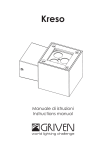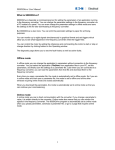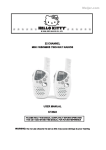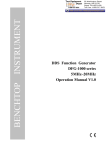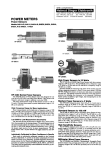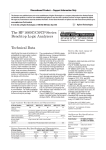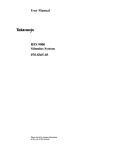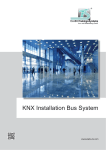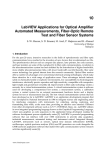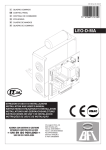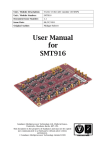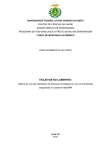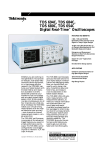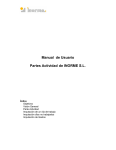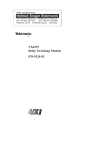Download Appendix B: Specifications
Transcript
Appendix B: Specifications The HFS 9000 family of high-speed logic signal source instruments have a modular architecture with factory-configurable cards. The channels are digitally synthesized from a common clock resulting in highly accurate independent placement of rising and falling edges. The instruments are optimized for digital device characterization with unique triggering capabilities and a variety of pulse outputs. The product family also features low RMS jitter, the ability to compensate for external cable skews, and an easy-to-use graphical human interface. This section contains the complete specifications for the HFS 9000 Stimulus System and Modules. These specifications are classified as either nominal traits, warranted characteristics, or typical characteristics. Nominal Traits Nominal traits are described using simple statements of fact such as “+2.6 V” for the trait “Maximum high level,” rather than in terms of limits that are performance requirements. Table B–1: Nominal Traits — HFS 9PG1 Output Performance Each channel and complement driving a 50 W load to ground, except as noted. Name Description Maximum high level +2.6 V Minimum low level –2.00 V Maximum amplitude 3.00 V Minimum amplitude 0.50 V Level resolution 0.01 V Operation when terminated through 50 W to –2 V Output levels will be approximately 1 V more negative than the values programmed, specified, and displayed. Actual output levels more negative than –2 V may cause malfunction. Level accuracy specifications do not apply when terminating to –2 V. Both true and complement outputs must be terminated to the same voltage. With compliments Helmut Singer Elektronik HFS 9000 User Manual www.helmut-singer.de [email protected] fon +49 241 155 315 fax +49 241 152 066 Feldchen 16-24 D-52070 Aachen Germany B–1 Appendix B: Specifications Table B–1: Nominal Traits — HFS 9PG1 Output Performance (Cont.) Each channel and complement driving a 50 W load to ground, except as noted. Name Description Operation when terminated to high impedance loads Output level range will double until certain internal limits are achieved. Since the programmed, specified, and displayed output levels do not match the actual output levels, level accuracy specifications do not apply when terminating to a high impedance load. Because of the larger voltage swings associated with doubled level range, output transition time specifications do not apply when driving a high impedance load. Output limits One high limit and one low limit may be enabled or disabled together. Table B–2: Nominal Traits — HFS 9PG2 Output Performance Each channel and complement driving a 50 W load to ground, except as noted. B–2 Name Description Maximum high level +5.50 V Minimum low level –2.00 V Maximum amplitude 5.50 V Minimum amplitude 0.50 V Level resolution 0.01 V Operation when terminated through 50 W to –2 V Output levels will be approximately 1 V more negative than the values programmed, specified, and displayed. Actual output levels more negative than –2 V may cause malfunction. Level accuracy specifications do not apply when terminating to –2 V. Both true and complement outputs must be terminated to the same voltage. Transition time 20% to 80% Variable from 800 ps to 5 ns Transition time resolution 10 ps Output limits One high limit and one low limit may be enabled or disabled together. HFS 9000 User Manual Appendix B: Specifications Table B–3: Nominal Traits — HFS 9DG1 Output Performance Each channel and complement driving a 50 W load to ground, except as noted. Name Description Maximum high level +5.0 V Minimum low level –2.5 V Maximum amplitude 3.00 V Minimum amplitude 0.01 V Level resolution 0.01 V Operation when terminated through 50 W to –2 V Output levels will be approximately 1 V more negative than the values programmed, specified, and displayed. Actual output levels more negative than –2 V may cause malfunction. Level accuracy specifications do not apply when terminating to –2 V. Both true and complement outputs must be terminated to the same voltage. Operation when terminated to high impedance loads Output level range will double until certain internal limits are achieved. Since the programmed, specified, and displayed output levels do not match the actual output levels, level accuracy specifications do not apply when terminating to a high impedance load. Because of the larger voltage swings associated with doubled level range, output transition time specifications do not apply when driving a high impedance load. Output limits One high limit and one low limit may be enabled or disabled together. Table B–4: Nominal Traits — HFS 9DG2 Output Performance Each channel and complement driving a 50 W load to ground, except as noted. HFS 9000 User Manual Name Description Maximum high level +5.50 V Minimum low level –2.00 V Maximum amplitude 5.50 V Minimum amplitude 0.01 V Level resolution 0.01 V Operation when terminated through 50 W to –2 V Output levels will be approximately 1 V more negative than the values programmed, specified, and displayed. Actual output levels more negative than –2 V may cause malfunction. Level accuracy specifications do not apply when terminating to –2 V. Both true and complement outputs must be terminated to the same voltage. Transition time 20% to 80% Variable from 800 ps to 6 ns B–3 Appendix B: Specifications Table B–4: Nominal Traits — HFS 9DG2 Output Performance (Cont.) Each channel and complement driving a 50 W load to ground, except as noted. Name Description Transition time resolution 10 ps Output limits One high limit and one low limit may be enabled or disabled together. Table B–5: Nominal Traits — Time Base Name Description Frequency range HFS 9PG1, HFS 9DG1: 50 kHz to 630 MHz HFS 9PG2, HFS 9DG2: 50 kHz to 300 MHz1 Frequency resolution ≤ 0.1% of frequency setting Minimum frequency setting when using half, quarter, or eighth pulse rate modes2 half pulse rate: 100 kHz quarter pulse rate: 200 kHz eighth pulse rate: 400 kHz Number of pulse periods in burst or auto-burst modes User selectable from 1 to 65,536 1 If the HFS 9PG2 or HFS 9DG2 is operated in half pulse rate mode, frequency can be extended to 600 MHz for the HFS 9PG2 and 630 MHz for the HFS 9DG2. 2 All pulse rate modes result in 50 kHz output frequency. Table B–6: Nominal Traits — Performance to External Frequency Reference B–4 Name Description PHASE LOCK IN input characteristic 0.1 mF DC blocking capacitor followed by 50 W termination to ground Phase lock output frequency range Any 2n multiple or sub-multiple of the phase lock frequency that is within the allowed frequency range for the card being used FRAME SYNC IN Initiates a burst when using phase lock mode FRAME SYNC IN input characteristic 50 W terminated to –2 V HFS 9000 User Manual Appendix B: Specifications Table B–7: Nominal Traits — Output Edge Placement Performance1 Name Description Channel deskew (Chan Delay) range, channels relative to time zero reference –60 ns to 2.0 ms Channel deskew (Chan Delay) resolution HFS 9PG1, HFS 9PG2: 5 ps HFS 9DG1, HFS 9DG2: 1 ps Delay (Lead Delay) adjustment range Zero to 20 ms Delay (Lead Delay, Trail Delay) adjustment resolution HFS 9PG1, HFS 9PG2: 5 ps HFS 9DG1, HFS 9DG2: 1 ps Pulse width adjustment range HFS 9PG1, HFS 9PG2: Zero to (one period – 790 ps) inclusive HFS 9DG1, HFS 9DG2: Zero to (one period × 65,536) inclusive Pulse width adjustment resolution HFS 9PG1, HFS 9PG2: 5 ps HFS 9DG1, HFS 9DG2: 1 ps Fine knob resolution of timing 5 ps 1 Measured at 50% levels, each channel independent. Table B–8: Nominal Traits — Transducer In Performance Name Description TRANSDUCER IN input characteristic HFS 9PG1: 1000 pF DC blocking capacitor followed by 50 W termination to ground HFS 9PG2: 100 pF DC blocking capacitor followed by 50 W termination to ground Table B–9: Nominal Traits — Skew Cal In Performance HFS 9000 User Manual Name Description SKEW CAL IN usage Calibration use only. No signal, except from a channel OUTPUT connector during the calibration process, should ever be applied to this input. B–5 Appendix B: Specifications Table B–10: Nominal Traits — Trigger In Performance Name Description Input Voltage range ±5 V maximum Trigger level range ±4.70 V Trigger level resolution 100 mV Table B–11: Nominal Traits — Trigger Out Performance Name Description Pretrigger range, TRIGGER OUT before time zero reference Zero to 70 ns TRIGGER OUT pulse width in auto mode 100 10 Width (ns) 1 0.1 0.01 0.1 1 10 100 Output Frequency (MHz) 1000 Table B–12: Nominal Traits — Power Requirements Name HFS 9003 Description HFS 9009 Description Fuse ratings 5 A, 250 V, type 3AG, (Tektronix part 159-0014-00), and 4 A, 250 V, type 3AG, fast blow, (Tektronix part 159-0017-00) 15 A, 250 V, type 3AG, fast blow, (Tektronix part 159-0256-00) Table B–13: Nominal Traits — System Memory Performance B–6 Name Description Non-volatile memory retention time Instrument settings and calibration constants are retained in non-volatile memory for 5 years or more. Card identification is retained for 10 years. Extended storage above 50_ C may degrade the life of all non-volatile memory. HFS 9000 User Manual Appendix B: Specifications Table B–14: Nominal Traits — HFS 9003 Mechanical Name Description Weight, in 12-channel configuration. (Shipping weight includes all standard accessories.) Net weight: Shipping weight: Overall Dimensions Width: Height: Depth: Depth behind rack flange: Cabinet 45 lbs. (20.5 kg) 60 lbs. (27.3 kg) Rackmount 51 lbs. (23.2 kg) 66 lbs. (30.0 kg) Cabinet 16.3 in. (414 mm) 7.0 in. (178 mm) 24.75 in. (629 mm) Rackmount 19.0 in (483 mm) 7.0 in. (178 mm) 24.75 in. (629 mm) — 22.0 in. (559 mm) Cooling Method Forced-air circulation with no air filter, maximum 318 cfm Construction Material Chassis parts are constructed of aluminum alloy; bezel is glass-filled polycarbonate with Lexan plastic inserts; cabinet is aluminum with textured epoxy paint. Table B–15: Nominal Traits — HFS 9009 Mechanical Name Description Weight, in 36-channel configuration. (Shipping weight includes all standard accessories.) Net weight: Shipping weight: Rackmount 81 lbs. (33.7 kg) 100 lbs. (45.3 kg) Width: Height: Depth: Rackmount 16.75 in (425.79 mm) 14.00 in. (355.89 mm) 24.00 in. (610.11 mm) Overall Dimensions HFS 9000 User Manual Cooling Method, mainframe Forced-air circulation with air filter, maximum 318 cfm Cooling Method, power supply Forced-air circulation, maximum 106 cfm Construction Material Chassis parts are constructed of aluminum alloy with Lexan plastic inserts; cabinet is aluminum with textured epoxy paint. B–7 Appendix B: Specifications Warranted Characteristics Warranted characteristics are described in terms of quantifiable performance limits which are warranted. Names of characteristics that appear in boldface type have checks for verifying the specifications in the Check Procedures section. Table B–16: Warranted Characteristics — HFS 9PG1 Output Performance Name Description High level accuracy (amplitude ≥ 1 V or high level ≥ 0 V)1 ±2% of level, ±50 mV Low level accuracy (amplitude ≥ 1 V or high level ≥ 0 V)1 ±2% of high level, ±2% of amplitude, ±50 mV Transition time 20% to 80% (amplitude ≤ 1 V) ≤ 200 ps 1 If amplitude < 1 V and high level < 0 V, accuracy typically meets the specification but is not guaranteed Table B–17: Warranted Characteristics — HFS 9PG2 Output Performance Name Description High level accuracy ±2% of level, ±50 mV Low level accuracy ±2% of high level, ±2% of amplitude, ±50 mV Transition time accuracy 20% to 80% (amplitude ≤ 1 V) ±10% of setting, ±300 ps Table B–18: Warranted Characteristics — HFS 9DG1 Output Performance Name Description High level accuracy (amplitude ≥ 0.5 V)1 ±2% of level, ±50 mV Low level accuracy (amplitude ≥ 0.5 V)1 ±2% of high level, ±2% of amplitude, ±50 mV Transition time 20% to 80% (amplitude ≤ 1 V) ≤ 250 ps 1 B–8 If amplitude < 0.5 V, accuracy typically meets the specification but is not guaranteed HFS 9000 User Manual Appendix B: Specifications Table B–19: Warranted Characteristics — HFS 9DG2 Output Performance Name Description High level accuracy (amplitude ≥ 0.5 V)1 ±2% of level, ±50 mV Low level accuracy (amplitude ≥ 0.5 V)1 ±2% of high level, ±2% of amplitude, ±50 mV Transition time accuracy 20% to 80% (amplitude ≤ 1 V) ±10% of setting, ±300 ps 1 If amplitude < 0.5 V, accuracy typically meets the specification but is not guaranteed. Table B–20: Warranted Characteristics — Time Base Name Description Frequency accuracy ±1% Table B–21: Warranted Characteristic — Performance to External Frequency Reference Name Description PHASE LOCK IN frequency range 6 MHz to 630 MHz Table B–22: Warranted Characteristics — Output Edge Placement Performance1 Name Description Delay of pulses relative to time zero reference (Lead Delay) accuracy HFS 9PG1, HFS 9PG2: 1% of (Lead Delay + Chan Delay) ±300 ps HFS 9DG1, HFS 9DG2: 1% of (Lead Delay + Chan Delay) ±50 ps Pulse width accuracy HFS 9PG1: 1% of width ±300 ps HFS 9PG2: 1% of width ±300 ps [for widths w 20 ns]; 1% of width)300 ps, –500 ps [for widths t 20 ns] HFS 9DG1: 1% of width )50 –75 ps HFS 9DG2: 1% of width)50 ps, –250 ps [for widths w 20 ns]; 1% of width)50 ps, –450 ps [for widths t 20 ns] 1 HFS 9000 User Manual Measured at 50% levels, each channel independent. B–9 Appendix B: Specifications Table B–23: Warranted Characteristics — Trigger Out Performance Name Description TRIGGER OUT signal levels Amplitude ≥ 300 mV (–0.5 V ≥ offset ≥ –1.5 V, driving 50 W to ground) Table B–24: Warranted Characteristics — Power Requirements Name Description Primary circuit dielectric breakdown voltage 1500 VACRMS, 60 Hz for 10 seconds without breakdown Primary Grounding 0.1 W maximum from chassis ground and protective earth ground Table B–25: Warranted Characteristics — Environmental and Safety B–10 Name HFS 9003 Description HFS 9009 Description Temperature Operating: 0_ C to +50_ C (32_ F to 122_ F) Non-operating (storage): –40_ C to +75_ C (–40_ F to 167_ F) Operating: 0_ C to +40_ C (32_ F to 104_ F) Non-operating (storage): –40_ C to +75_ C (–40_ F to 167_ F) Altitude Operating: 4 hours at 3,048 m (10,000 feet). Derate maximum operating temperature by –1_ C (–1.8_ F) for each 304.8 m (1,000 feet) above 1,524 m (5,000 feet) Non-operating: 2 hours at 12,192 m (40,000 feet) Humidity Operating: t95% RH, non-condensing, from 0_ C to 30_ C (32_ F to 86_ F) t75% RH, non-condensing, from 31_ C to 40_ C (88_ F to 104_ F) (MIL-T-28800E, para 4.5.5.1.2.2, Type III, Class 5) Shock (non-operating) MIL-T-28800E, para 4.5.5.4.1, Type III, Class 5 Resistance to mishandling during bench use (operating) MIL-T-28800E, para 4.5.5.4.3, Type III, Class 5 Resistance to packaged transportation vibration, sinusoidal, in shipping package Drops of 36 inches on all edges, faces, and corners National Safe Transit Association, test procedure 1A-B-2 Resistance to packaged transportation vibration, sinusoidal, in shipping package Packaged sinusoidal vibration National Safe Transit Association, test procedure 1A-B-1 Resistance to packaged transportation random vibration MIL-STD-810D, method 514.3, category I, Figure 514.3-1 HFS 9000 User Manual Appendix B: Specifications Table B–25: Warranted Characteristics — Environmental and Safety (Cont.) Name HFS 9003 Description HFS 9009 Description Safety Listed to UL1244 Certified to CAN/CSA-C22.2 No. 231–M89 IEC Specifications Installation Category II Pollution Degree 2 Safety Class I Typical Characteristics Typical characteristics are described in terms of typical or average performance. Typical characteristics are not warranted. Table B–26: Typical Characteristics — Time Base Name Description RMS jitter 15 ps, ±0.05% of interval Recovery time between bursts or auto-bursts 15 ms Table B–27: Typical Characteristics — HFS 9PG1 Output Performance HFS 9000 User Manual Name Description Transition time 20% to 80% Amplitude ≤ 1 V: 150 ps 1 V < Amplitude ≤ 2 V: 190 ps 2 V < Amplitude ≤ 3 V: 225 ps Output aberrations (beginning 200 ps after 50% point of transition) Overshoot: +15%, +20 mV Undershoot: –10%, –20 mV B–11 Appendix B: Specifications Table B–28: Typical Characteristics — HFS 9PG2 Output Performance Name Description Operation when terminated to high impedance loads Output level range will double until certain internal limits are achieved. Since the programmed, specified, and displayed output levels do not match the actual output levels, level accuracy specifications do not apply when terminating to a high impedance load. Because of the larger voltage swings associated with doubled level range, output transition time specifications do not apply when driving a high impedance load. Transition time accuracy 20% to 80% ±10% of setting, ±300 ps Output aberrations Overshoot: +15%, +20 mV Undershoot: –10%, –20 mV Table B–29: Typical Characteristics — HFS 9DG1 Output Performance Name Description Transition time 20% to 80% Amplitude ≤ 1 V: ≤ 250 ps, 250 ps 1 V < Amplitude < 2 V: 250 ps 2 V ≤ Amplitude ≤ 3 V: 260 ps Output aberrations Overshoot: +15%, +20 mV Undershoot: –10%, –20 mV Table B–30: Typical Characteristics — HFS 9DG2 Output Performance B–12 Name Description Operation when terminated to high impedance loads Output level range will double until certain internal limits are achieved. Since the programmed, specified, and displayed output levels do not match the actual output levels, level accuracy specifications do not apply when terminating to a high impedance load. Because of the larger voltage swings associated with doubled level range, output transition time specifications do not apply when driving a high impedance load. Transition time accuracy 20% to 80% ±10% of setting, ±300 ps Output aberrations Overshoot: +15%, +20 mV Undershoot: –10%, –20 mV HFS 9000 User Manual Appendix B: Specifications Table B–31: Typical Characteristics — Performance to External Frequency Reference Name Description PHASE LOCK IN amplitude range 0.8 V to 1.0 V peak-to-peak PHASE LOCK IN transition time requirement 20% to 80% in ≤ 10 ns FRAME SYNC IN signal level –1.810 V ≤ Vlow ≤ –1.475 V –1.165 V ≤ Vhigh ≤ –0.810 V (standard 100 K ECL levels) Setup time, rising edge of FRAME SYNC IN signal to rising edge of PHASE LOCK IN 650 ps minimum Hold time, high level of FRAME SYNC IN after rising edge of PHASE LOCK IN 650 ps minimum Time from frame sync qualified phase lock clock cycle to timezero reference 70 ns minimum, 130 ns Table B–32: Typical Characteristics — Transducer In Performance Name Description TRANSDUCER IN useful frequency range HFS 9PG1: 25 MHz to > 1 GHz HFS 9PG2: 5 MHz to 300 MHz TRANSDUCER IN amplitude requirement 1.0 V to 1.5 V peak-to-peak Table B–33: Typical Characteristics — Trigger In Performance HFS 9000 User Manual Name Description Input resistance 50 W Trigger level accuracy ±100 mV ±5% of trigger level Trigger input rise/fall time requirement ≤ 10 ns Minimum trigger input pulse width 1 ns Trigger sensitivity ≤ 500 mV Time from trigger in to time-zero reference 70 ns minimum, 130 ns typical B–13 Appendix B: Specifications Table B–34: Typical Characteristics — Trigger Out Performance Name Description Pretrigger resolution 250 ps Table B–35: Typical Characteristics — Power Requirements B–14 Name HFS 9003 Description HFS 9009 Description Line Voltage 90 VACRMS to 130 VACRMS or 180 VACRMS to 250 VACRMS, range switched automatically 90 VACRMS to 104 VACRMS with maximum 7 cards installed, 104 VACRMS to 132 VACRMS with maximum 9 cards installed, or 180 VACRMS to 250 VACRMS, range switched automatically Line frequency 48 Hz to 63 Hz Power consumption 540 W maximum Inrush surge current 50 A maximum up to 40 ms at 110 VAC 100 A maximum up to 40 ms at 220 VAC 1190 W with maximum of 9 cards installed HFS 9000 User Manual Appendix C: Interface Specifications This appendix describes details of the remote interfaces of the Stimulus System, both the serial port (RS-232-C) and GPIB. Normally, you will not need this information to use the HFS 9000, but the information is useful when connecting to controllers of unusual configuration. This appendix also contains general information that pertains to programming with both interfaces including a chart of the ASCII character set and a list of reserved words. Interface Messages Table C–1 shows the standard interface messages that are supported by the HFS 9000. Table C–1: HFS 9000 Standard Interface Messages HFS 9000 User Manual Message GPIB RS-232-C DCL GET Yes Yes Yes (provided by Break) Yes (provided by *TRG) GTL Yes No LLO Yes No PPC No No PPD No No PPE No No PPU No No SDC Yes No SPD Yes No SPE Yes No UNL Yes No UNT Yes No Listen Addresses Yes No Talk Addresses Yes No C–1 Appendix C: Interface Specifications Character Set (ASCII Chart) Table C–2 shows the character set used for all messages to and from the HFS 9000. This is identical to standard ASCII. Table C–2: The ASCII Character Set 0 0 1 NUL DLE 0 1 SOH DC1 STX 3 ETX DC3 EOT 5 ENQ NAK ACK 7 BS 9 HT A LF B VT C FF D CR E SO F SI C–2 = . M > N 62 ? 47 O 63 } n 125 ~ 110 o 95 124 109 94 _ 79 | m ^ 123 108 93 78 { l ] 122 107 92 77 z k \ 121 106 91 76 61 46 / 31 L y j [ 120 105 90 75 60 45 30 US 15 < – RS K x i Z 119 104 89 74 59 44 29 14 ; , GS J w h Y 118 103 88 73 58 43 28 13 : + FS I v g X 117 102 87 72 57 42 27 12 9 * ESC H u f W 116 101 86 71 56 41 26 11 8 ) SUB G t e V 115 100 85 70 55 40 25 10 7 ( EM F s d U 114 99 84 69 54 39 24 9 6 ’ CAN E r c T 113 98 83 68 53 38 23 8 5 & ETB D q b S 112 97 82 67 52 37 22 7 8 % SYN BEL 4 a R C p 96 81 66 51 36 21 6 3 $ Q B 7 ‘ 80 65 50 35 20 5 6 # DC4 A 2 6 P 64 49 34 19 4 1 ” 5 @ 48 33 18 3 4 ! DC2 4 0 32 17 2 3 space 16 1 2 2 126 rubout 111 127 HFS 9000 User Manual Appendix C: Interface Specifications Reserved Words The following is a list of the reserved words of the HFS 9000. You cannot use these words as names of aliases. ABUR ABURS ABURST ALI ALIA ALIAS ALL AMPL AMPLI AMPLIT AMPLITU AMPLITUD AMPLITUDE AUTO BAUD BURS BURST CAL CAT CATA CATAL CATALO CATALOG CDEL CDELA CDELAY CH1 CH2 CH3 CH4 CID COAR COARS COARSE COMP COMPL COMPLE COMPLEM COMPLEME COMPLEMEN COMPLEMENT CONS CONST CONSTA CONSTAN CONSTANT COUN COUNT COUT COUTP COUTPU COUTPUT CR CRLF DCH DCHA DCHAN DCHANN DCHANNE DCHANNEL DCYC DCYCL DCYCLE DEF DEFI DEFIN DEFINE DEL DELA DELAY DELE DELET DELETE DESE DISP DISPL DISPLA DISPLAY DIT DITE DITEM DMEN DMENU DSET DSETT HFS 9000 User Manual DSETTI DSETTIN DSETTING ECHO EOL EVEN EVENT EVMSG FACTORY FINE FLAG FLAGG FLAGGI FLAGGIN FLAGGING FPAN FREQ FREQU FREQUE FREQUEN FREQUENC FREQUENCY HALF HARD HEADER HIGH HLIM HLIMI HLIMIT INP INPU INPUT KEY KRES KRESO KRESOL KRESOLU KRESOLUT KRESOLUTI KRESOLUTIO KRESOLUTION LDEL LDELA LDELAY LEV LEVE LEVEL LF LFCR LHOL LHOLD LIM LIMI LIMIT LLIM LLIMI LLIMIT LOW LVI LVIE LVIEW MAX MESS MESSA MESSAG MESSAGE MIN MODE NAME NEG NEGA NEGAT NEGATI NEGATIV NEGATIVE NONE NORM NORMA NORMAL ODD OFF OFFS OFFSE OFFSET ON ONE OUTP OUTPU OUTPUT PAR PARI PARIT PARITY PER PERI PERIO PERIOD PGENA PGENB PGENC PGEND PGENE PGENF PGENG PGENH PGENI PGENJ PGENK PHAS PHASE PLIN POL POLA POLAR POLARI POLARIT POLARITY POS POSI POSIT POSITI POSITIV POSITIVE PRAT PRATE PRET PRETR PRETRI PRETRIG PRETRIGG PRETRIGGE PRETRIGGER PURGE PVI PVIE PVIEW RS232 SBIT SBITS SLOP SLOPE SOFT TBAS TDEL TDELA TDELAY THOL THOLD TIN TINP TINPU TINPUT TOUT TRAN TRANS TRANSI TRANSIT TRANSITI TRANSITIO TRANSITION TRIG TRIGG TRIGGE TRIGGER VERBOSE WIDT WIDTH ZERO C–3 Appendix C: Interface Specifications Using Debug Mode You can turn on Debug from either the GPIB or RS-232 menu. The purpose of debug mode is to let you observe command operation as commands are sent to the HFS 9000. Debug is especially useful when you are trying to debug a program and you have the controller set to single-step through the commands. When debug mode is on, the debug window (see Figure C-1) is displayed above the menu. This window is present regardless of which menu is displayed. Figure C-1: The Debug Window The bottom three rows of the debug window show the most recent commands received by the HFS 9000, regardless of which interface received them (GPIB or RS-232). The row of the debug window shows several indicators which appear only when appropriate. The indicators and their meanings are: C–4 H REM. The HFS 9000 is in the remote state. Generally, remote means that the HFS 9000 expects to receive commands through the GPIB. If local lockout is enabled with remote, the front panel is rendered inactive (except for the SRQ button and the pulse generator channel buttons), and the REMOTE light on the front panel is lit. If local lockout has not been enabled, then front-panel commands will be entered and executed regardless of the remote or local state. When you de-assert the remote enable line, local lockout is reset automatically. Refer to the documentation on your controller to determine how you control the remote enable line. H LLO. The HFS 9000 is in local lockout mode. The front panel is inactive when both the LLO command is received and REM (remote enable) is asserted. Use the LLO command to assert local lockout mode. Once local lockout mode is asserted, you can reset it by de-asserting remote enable. H ATN. The attention line is asserted (low) on the GPIB. This means that the controller is sending an interface command on the bus. When not asserted, the data I/O lines are carrying data. H LADS. The HFS 9000 is addressed on the GPIB to listen. H TADS. The HFS 9000 is addressed on the GPIB to talk. H RS232 Error. An error has occurred during I/O on the RS-232-C interface. Check the RS-232-C settings, especially Baud Rate, Parity, and Stop Bits. This error flag can also occur when the input buffer has overflowed, which HFS 9000 User Manual Appendix C: Interface Specifications may indicate the controller failing to acknowledge that the HFS 9000 has flagged busy by sending an XOff character. See XOff> below. You can clear the RS232 Error flag by turning Debug off and then on. H >XOff. An XOff character has been received by the HFS 9000 on the RS-232-C controller. The HFS 9000 has responded by suspending output. When the HFS 9000 receives an XOn character, output will resume. H XOff>. The HFS 9000 has sent an XOff character to the RS-232-C controller because the HFS 9000 input buffer is nearly full. The controller should acknowledge the XOff character by not sending any more characters until the HFS 9000 sends an XOn character. If the controller fails to respond to the HFS 9000 XOff request within three characters, the RS232 Error flag may turn on to indicate possible loss of data. GPIB Function Subsets The HFS 9000 supports many GPIB function subsets, as listed below. Some of the listings describe subsets that the HFS 9000 does not support. HFS 9000 User Manual H SH1 (Source Handshake). The HFS 9000 can transmit multi-line messages across the GPIB. H AH1 (Acceptor Handshake). The HFS 9000 can receive multi-line messages across the GPIB. H T6 (Talker). The HFS 9000 becomes a talker when its talk address is sent with the ATN (Attention) line asserted. It ceases to be a talker when another device’s talk address is sent with ATN asserted. The HFS 9000 has no talk-only capability. H L4 (Listener). The HFS 9000 becomes a listener when its listen address is sent with the ATN (Attention) line asserted. The HFS 9000 does not have listen-only capability. H SR1 (Service Request). The HFS 9000 asserts an SRQ (Service Request) line to notify the controller when it requires service. H RL1 (Remote/Local). The HFS 9000 responds to both the GTL (Go To Local) and LLO (Local Lock Out) interface messages. H PPO (Parallel Poll). The HFS 9000 has no parallel poll capability. It does not respond to the following interface messages: PPC, PPD, PPE, and PPU. The HFS 9000 does not send out a status message when the ATN (Attention) and EOI (End of Instruction) lines are asserted simultaneously. C–5 Appendix C: Interface Specifications H DCL (Device Clear). When acting as a listener, the HFS 9000 responds to the DCL (Device Clear) and SDC (Selected Device Clear) interface messages. H DT1 (Device Trigger). The HFS 9000 responds to the GET (Group Execute Trigger) interface message. H C0 (Controller). The HFS 9000 cannot control other devices. H E2 (Electrical). The HFS 9000 uses tri-state buffers to provide optimal high-speed data transfer. Wiring for Alternate RS-232-C Configurations The RS-232-C cable included with the HFS 9000 connects the HFS 9000 to a standard RS-232-C serial port with a DB-25 female connector configured as DCE (Data Communications Equipment). If your controller is configured differently, you will need to obtain or build a different cable or adapter. The information below will assist a qualified service person to identify or build the necessary custom cable. Serial Port DB-9 Pin Assignments The HFS 9000 serial port is a 9-pin male connector with the following pin assignments listed in Table C–3. This port configuration is equivalent to the Compaq personal computer 9-pin serial port. Table C–3: Serial Port DB-9 Pin Assignments Standard Accessory Serial Cable C–6 Pin RS-232-C Signal Name 1 DCD — Carrier Detect 2 RXD — Receive Data 3 TXD — Transmit Data 4 DTR — Data Terminal Ready 5 Signal Ground 6 DSR — Data Set Ready 7 RTS — Request To Send 8 CTS — Clear To Send 9 RNG — Ring Indicator The standard accessory serial cable supplied with the HFS 9000, Tektronix part number 012-1241-00, connects the HFS 9000 to a standard RS-232-C serial port with a DB-25 female connector configured as DCE (Data Communications Equipment). HFS 9000 User Manual Appendix C: Interface Specifications In effect, the standard accessory serial cable converts the HFS 9000 to a standard RS-232-C serial port with a DB-25 male connector configured as DTE (Data Terminal Equipment). Table C–4 shows the wiring of the standard accessory cable. This table also shows the standard cable’s effective pin assignments at the DB-25 connector when the DB-9 connector is attached to the HFS 9000. Table C–4: Standard Accessory Cable Connections Connection to IBM PC DB-25 Ports DB-9 Female 9-Pin Connector Pin Number DB-25 Male 25-Pin Connector Pin Number RS-232-C Pin Assignments when Cable Connected to HFS 9000 1 8 DCD — Carrier Detect 2 3 RXD — Receive Data 3 2 TXD — Transmit Data 4 20 DTR — Data Terminal Ready 5 7 Signal Ground 6 6 DSR — Data Set Ready 7 4 RTS — Request To Send 8 5 CTS — Clear To Send 9 22 RNG — Ring Indicator The easiest way to connect to an IBM PC or PC clone is to create a “null modem” or converter. This connects to the IBM PC serial port, and the standard accessory cable connects to the null modem. The converter is non-polarized; it can be connected either way between the standard accessory cable and the IBM PC serial port. The wiring for the null modem is shown in Table C–5. Table C–5: Converter Wiring for 25-pin PCs HFS 9000 User Manual DB-25 Female 25-Pin Connector Pin Number DB-25 Female 25-Pin Connector Pin Number 1 1 2 3 3 2 4 8 5 and 6 20 8 4 20 5 and 6 C–7 Appendix C: Interface Specifications Connection to IBM PC DB-9 Ports To connect the HFS 9000 to an IBM PC or compatible having DB-9 (9-pin) serial ports, do not use the standard accessory cable at all. Instead, obtain a DB-9 to DB-9 cable with the wiring shown in Table C–6. Either end of this cable may be connected to either the HFS 9000 or the IBM PC. Table C–6: Converter Cable for 9-pin PCs1 DB-9 Female 9-Pin Connector Pin Number DB-9 Female 9-Pin Connector Pin Number 1 7 2 3 3 2 4 6 and 8 5 5 6 and 8 4 7 1 1 Neither connector uses pin 9. With compliments Helmut Singer Elektronik www.helmut-singer.de [email protected] fon +49 241 155 315 fax +49 241 152 066 Feldchen 16-24 D-52070 Aachen Germany C–8 HFS 9000 User Manual






















